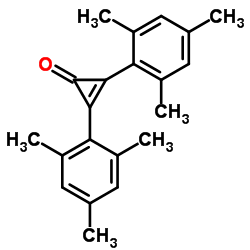61440-88-8
| Name | 2,3-bis(2,4,6-trimethylphenyl)cycloprop-2-en-1-one |
|---|---|
| Synonyms |
bis(2,4,6-trimethylphenyl)cyclopropenone
2,3-dimesitylcyclopropenone MFCD00051390 2,3-Bis(2,4,6-trimethylphenyl)cyclopropenone 2-Cyclopropen-1-one,2,3-bis(2,4,6-trimethylphenyl) 2,3-Dimesityl-2-cyclopropen-1-one 1,2-dimesitylcyclopropenoe 2-Cyclopropen-1-one, 2,3-bis(2,4,6-trimethylphenyl)- dimesitylcyclopropenone |
| Density | 1.1±0.1 g/cm3 |
|---|---|
| Boiling Point | 479.1±45.0 °C at 760 mmHg |
| Molecular Formula | C21H22O |
| Molecular Weight | 290.399 |
| Flash Point | 210.6±23.7 °C |
| Exact Mass | 290.167053 |
| PSA | 17.07000 |
| LogP | 6.54 |
| Vapour Pressure | 0.0±1.2 mmHg at 25°C |
| Index of Refraction | 1.606 |
Synonym:None Known Section 2 - COMPOSITION, INFORMATION ON INGREDIENTS
Risk Phrases: None Listed. Section 3 - HAZARDS IDENTIFICATION EMERGENCY OVERVIEW
The toxicological properties of this material have not been fully investigated. Potential Health Effects Eye: May cause eye irritation. Skin: May cause skin irritation. May be harmful if absorbed through the skin. Ingestion: May cause irritation of the digestive tract. The toxicological properties of this substance have not been fully investigated. May be harmful if swallowed. Inhalation: May cause respiratory tract irritation. The toxicological properties of this substance have not been fully investigated. May be harmful if inhaled. Chronic: No information found. Section 4 - FIRST AID MEASURES Eyes: In case of contact, immediately flush eyes with plenty of water for at least 15 minutes. Get medical aid. Skin: In case of contact, flush skin with plenty of water. Remove contaminated clothing and shoes. Get medical aid if irritation develops and persists. Wash clothing before reuse. Ingestion: If swallowed, do not induce vomiting unless directed to do so by medical personnel. Never give anything by mouth to an unconscious person. Get medical aid. Inhalation: Remove from exposure and move to fresh air immediately. If not breathing, give artificial respiration. If breathing is difficult, give oxygen. Get medical aid. Notes to Physician: Treat symptomatically and supportively. Section 5 - FIRE FIGHTING MEASURES General Information: As in any fire, wear a self-contained breathing apparatus in pressure-demand, MSHA/NIOSH (approved or equivalent), and full protective gear. During a fire, irritating and highly toxic gases may be generated by thermal decomposition or combustion. Extinguishing Media: In case of fire, use carbon dioxide, dry chemical powder or appropriate foam. Section 6 - ACCIDENTAL RELEASE MEASURES General Information: Use proper personal protective equipment as indicated in Section 8. Spills/Leaks: Clean up spills immediately, observing precautions in the Protective Equipment section. Sweep up or absorb material, then place into a suitable clean, dry, closed container for disposal. Avoid generating dusty conditions. Provide ventilation. Section 7 - HANDLING and STORAGE Handling: Wash thoroughly after handling. Use with adequate ventilation. Minimize dust generation and accumulation. Avoid contact with eyes, skin, and clothing. Keep container tightly closed. Avoid ingestion and inhalation. Storage: Store in a cool, dry place. Store in a tightly closed container. Section 8 - EXPOSURE CONTROLS, PERSONAL PROTECTION Engineering Controls: Facilities storing or utilizing this material should be equipped with an eyewash facility and a safety shower. Use process enclosure, local exhaust ventilation, or other engineering controls to control airborne levels. Exposure Limits CAS# 61440-88-8: Personal Protective Equipment Eyes: Wear appropriate protective eyeglasses or chemical safety goggles as described by OSHA's eye and face protection regulations in 29 CFR 1910.133 or European Standard EN166. Skin: Wear appropriate protective gloves to prevent skin exposure. Clothing: Wear appropriate protective clothing to minimize contact with skin. Respirators: A respiratory protection program that meets OSHA's 29 CFR 1910.134 and ANSI Z88.2 requirements or European Standard EN 149 must be followed whenever workplace conditions warrant respirator use. Section 9 - PHYSICAL AND CHEMICAL PROPERTIES Physical State: Chunks Color: light yellow Odor: Not available. pH: Not available. Vapor Pressure: Not available. Viscosity: Not available. Boiling Point: Not available. Freezing/Melting Point: Not available. Autoignition Temperature: Not available. Flash Point: Not available. Explosion Limits, lower: Not available. Explosion Limits, upper: Not available. Decomposition Temperature: Solubility in water: Specific Gravity/Density: Molecular Formula: C21H24O Molecular Weight: 292.1674 Section 10 - STABILITY AND REACTIVITY Chemical Stability: Stable under normal temperatures and pressures. Conditions to Avoid: Dust generation. Incompatibilities with Other Materials: Strong oxidizing agents. Hazardous Decomposition Products: Carbon monoxide, carbon dioxide. Hazardous Polymerization: Has not been reported Section 11 - TOXICOLOGICAL INFORMATION RTECS#: CAS# 61440-88-8 unlisted. LD50/LC50: Not available. Carcinogenicity: Dimesitylcyclopropenone - Not listed by ACGIH, IARC, or NTP. Section 12 - ECOLOGICAL INFORMATION Section 13 - DISPOSAL CONSIDERATIONS Dispose of in a manner consistent with federal, state, and local regulations. Section 14 - TRANSPORT INFORMATION IATA Not regulated as a hazardous material. IMO Not regulated as a hazardous material. RID/ADR Not regulated as a hazardous material. Section 15 - REGULATORY INFORMATION European/International Regulations European Labeling in Accordance with EC Directives Hazard Symbols: Not available. Risk Phrases: Safety Phrases: S 24/25 Avoid contact with skin and eyes. WGK (Water Danger/Protection) CAS# 61440-88-8: No information available. Canada None of the chemicals in this product are listed on the DSL/NDSL list. CAS# 61440-88-8 is not listed on Canada's Ingredient Disclosure List. US FEDERAL TSCA CAS# 61440-88-8 is not listed on the TSCA inventory. It is for research and development use only. SECTION 16 - ADDITIONAL INFORMATION N/A |
| Safety Phrases | S24/25 |
|---|
|
~70% 
61440-88-8 |
| Literature: Poloukhtine, Andrei; Popik, Vladimir V. Journal of Organic Chemistry, 2003 , vol. 68, # 20 p. 7833 - 7840 |
|
~8% 
61440-88-8 |
| Literature: Dehmlow, Eckehard V.; Winterfeldt, Andreas Tetrahedron, 1989 , vol. 45, # 10 p. 2925 - 2936 |
|
~% 
61440-88-8 |
| Literature: Hardee, David J.; Kovalchuke, Lyudmila; Lambert, Tristan H. Journal of the American Chemical Society, 2010 , vol. 132, # 14 p. 5002 - 5003 |
|
~% 
61440-88-8 |
| Literature: Hardee, David J.; Kovalchuke, Lyudmila; Lambert, Tristan H. Journal of the American Chemical Society, 2010 , vol. 132, # 14 p. 5002 - 5003 |








